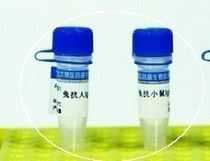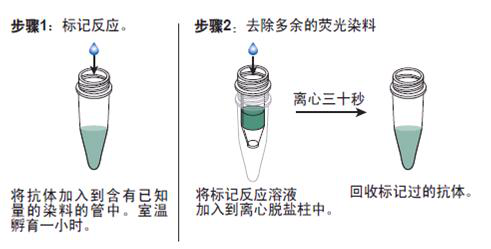
|

| 产地 | 进口、国产 |
| 品牌 | 上海莼试 |
| 保存条件 | Store at -20 °C |
| 货号 | CS10092 |
| 应用范围 | WB=1:100-500 ELISA=1:500-1000 IP=1:20-100 IHC-P=1:100-500 IHC-F=1:100-500 IF=1:100-500 |
| CAS编号 | |
| 抗体名 | Anti-OPGL/RANKL/ODF |
| 克隆性 | |
| 靶点 | 详见说明书 |
| 适应物种 | 详见说明书 |
| 形态 | 详见说明书 |
| 宿主 | 详见说明书 |
| 亚型 | IgG |
| 标识物 | 详见说明书 |
| 浓度 | 1mg/1ml% |
| 免疫原 | KLH conjugated synthetic peptide derived from human OPGL C-terminus |
产品订购信息:
英文名称 Anti-OPGL/RANKL/ODF
中文名称 骨保护蛋白配体抗体(破骨细胞分化因子)说明书
别 名 CD254; hRANKL2; ODF; OPGL; Osteoclast differentiation factor; Osteoprotegerin ligand; RANKL; Receptor activator of nuclear factor kappa B ligand; sOdf; SOFA; TNF related activation induced cytokine; TNFSF 11; TNFSF11; TRANCE; Tumor necrosis factor ligand superfamily member 11; Osteoprotegerin Ligand; TNF11_HUMAN.


浓 度 1mg/1ml
规 格 0.1ml/100μg 0.2ml/200μg
抗体来源 Rabbit
克隆类型 polyclonal
交叉反应 Human, Mouse, Rat, Dog
产品类型 一抗
研究领域 细胞生物 免疫学 发育生物学
蛋白分子量 predicted molecular weight: 35kDa
性 状 Lyophilized or Liquid
免 疫 原 KLH conjugated synthetic peptide derived from human OPGL C-terminus
亚 型 IgG
纯化方法 affinity purified by Protein A
储 存 液 0.01M PBS, pH 7.4 with 10 mg/ml BSA and 0.1% Sodium azide
骨保护蛋白配体抗体(破骨细胞分化因子)说明书 产品应用 WB=1:100-500 ELISA=1:500-1000 IP=1:20-100 IHC-P=1:100-500 IHC-F=1:100-500 IF=1:100-500
(石蜡切片需做抗原修复)
not yet tested in other applications.
optimal dilutions/concentrations should be determined by the end user.
保存条件 Store at -20 °C for one year. Avoid repeated freeze/thaw cycles. The lyophilized antibody is stable at room temperature for at least one month and for greater than a year when kept at -20°C. When reconstituted in sterile pH 7.4 0.01M PBS or diluent of antibody the antibody is stable for at least two weeks at 2-4 °C.
Important Note This product as supplied is intended for research use only, not for use in human, therapeutic or diagnostic applications.
产品介绍 This gene encodes a member of the tumor necrosis factor (TNF) cytokine family which is a ligand for osteoprotegerin and functions as a key factor for osteoclast differentiation and activation. This protein was shown to be a dentritic cell survival factor and is involved in the regulation of T cell-dependent immune response. T cell activation was reported to induce expression of this gene and lead to an increase of osteoclastogenesis and bone loss. This protein was shown to activate antiapoptotic kinase AKT/PKB through a signaling complex involving SRC kinase and tumor necrosis factor receptor-associated factor (TRAF) 6, which indicated this protein may have a role in the regulation of cell apoptosis. Targeted disruption of the related gene in mice led to severe osteopetrosis and a lack of osteoclasts. The deficient mice exhibited defects in early differentiation of T and B lymphocytes, and failed to form lobulo-alveolar mammary structures during pregnancy. Two alternatively spliced transcript variants have been found.
Function : Cytokine that binds to TNFRSF11B/OPG and to TNFRSF11A/RANK. Osteoclast differentiation and activation factor. Augments the ability of dendritic cells to stimulate naive T-cell proliferation. May be an important regulator of interactions between T-cells and dendritic cells and may play a role in the regulation of the T-cell-dependent immune response. May also play an important role in enhanced bone-resorption in humoral hypercalcemia of malignancy.
Subcellular Location : Cytoplasm; Secreted and Cell membrane.
Tissue Specificity : Highest in the peripheral lymph nodes, weak in spleen, peripheral blood Leukocytes, bone marrow, heart, placenta, skeletal muscle, stomach and thyroid.
Post-translational modifications : The soluble form of isoform 1 derives from the membrane form by proteolytic processing (By similarity). The cleavage may be catalyzed by ADAM17.
DISEASE : Defects in TNFSF11 are the cause of osteopetrosis autosomal recessive type 2 (OPTB2) [MIM:259710]; also known as osteoclast-poor osteopetrosis. Osteopetrosis is a rare genetic disease characterized by abnormally dense bone, due to defective resorption of immature bone. The disorder occurs in two forms: a severe autosomal recessive form occurring in utero, infancy, or childhood, and a benign autosomal dominant form occurring in adolescence or adulthood. Autosomal recessive osteopetrosis is usually associated with normal or elevated amount of non-functional osteoclasts. OPTB2 is characterized by paucity of osteoclasts, suggesting a molecular defect in osteoclast development.
Similarity : Belongs to the tumor necrosis factor family.
Database links : UniProtKB/Swiss-Prot: O14788.1
Entrez Gene: 8600 Human
Entrez Gene: 21943 Mouse
Omim: 602642 Human
SwissProt: O14788 Human
SwissProt: O35235 Mouse
Unigene: 333791 Human
Unigene: 249221 Mouse
OPGL骨保护蛋白配体又称骨保护素配体(破骨细胞发育刺激因子)。属TNF-a家族。
OPGL促进破骨细胞的分化和活性,而OPG抑制这些过程。细胞影响骨髓中这两种蛋白的生理平衡,是发生溶骨性的根本所在。

HIF-1Alpha (Hypoxia-inducible factor -1Alpha) 缺氧诱导因子1α (抗原)Multi-class antibodies规格: 0.5mg
Anti-CD166/ALCAM/MEMD 活化白细胞粘附分子抗体Multi-class antibodies规格: 0.2ml
Rhesus antibody Rh PAR3 蛋白酶激活受体3抗体 规格 0.2ml
TREM2 Kit Human 人 TREM-2 / TREM2 ELISA配对抗体 ELISA
phospho-TPH (Ser260) 英文名称: 磷酸化色酸羟化酶抗体 0.1ml
NT5C2 英文名称: 胞浆-5′-核苷酸酶-Ⅱ抗体 0.1ml
Anti-CD166/ALCAM/MEMD 活化白细胞粘附分子抗体Multi-class antibodies规格: 0.2ml
HHV8/ORF K2/vIL-6(Human herpesvirus 8) 人类病毒8抗原Multi-class antibodies规格: 0.5mg
Anti-CD163/M130 CD163抗体Multi-class antibodies规格: 0.2ml
Rhesus antibody Rh PAR3 型蛋白激酶C特定相互作用蛋白抗体 规格 0.1ml
NOV Kit Human 人 CCN3 / NOV / IGFBP9 ELISA配对抗体 ELISA
TPA 英文名称: 组织型纤溶酶原激活剂抗体 0.1ml
CD86 英文名称: CD86抗体 0.1ml
Anti-CD163/M130 CD163抗体Multi-class antibodies规格: 0.2ml
NN-T4 ELISA Kit 大鼠新生甲状腺素Multi-class antibodies规格: 48T
Anti-ATPase Na+/K+protein/FITC 荧光素标记ATP酶通道蛋白抗体IgGMulti-class antibodies规格: 0.2ml
Rhesus antibody Rh F-Actin 纤维状肌动蛋白抗体 规格 0.1ml
sCD30(Mouse soluble cluster of differentiation 30) Elisa Kit 小鼠可溶性CD30 96T
music Acetylcholine Receptor 1 英文名称: 毒蕈碱型乙酰胆碱受体M1抗体 0.1ml
Gamma-Adaptin 英文名称: 衔接蛋白γ/γ-Adaptin抗体 0.1ml
Anti-ATPase Na+/K+protein/FITC 荧光素标记ATP酶通道蛋白抗体IgGMulti-class antibodies规格: 0.2ml
TDGF1 Protein Rat 重组大鼠 Cripto / TDGF1 蛋白 (Fc 标签)
LS174T 人细胞
CD6 Others Mouse 小鼠 CD6 / TP120 人细胞裂解液 (阳性对照)
MDA-MB-231人癌细胞 Human breast cancer cell line MDA-MB-231 L-15+10% Hyclone FBS
T739小鼠肺腺株;LA795
人羊膜细胞;WISH SGC-7901, 人胃腺癌细胞系 Human
CL-0303PATU8988(人*癌细胞)5×106cells/瓶×2
CD40LG Others Canine 狗 CD40L / CD154 / TNFSF5 人细胞裂解液 (阳性对照)
人平滑肌细胞总RNAHBVSMC tDNA
山羊皮肤成纤维样细胞;DG-S1 胚肾细胞,AAV-293细胞 HP615细胞,615小鼠瘤株
人干细胞因子单克隆抗体细胞株;AMS2(SCF3)
HA Others H5N1 甲型 H5N1 (A/Common magpie/Hong Kong/2256/2006) 血凝素 (Hemagglutinin / HA) 人细胞裂解液 (阳性对照)
骨保护蛋白配体抗体(破骨细胞分化因子)说明书 TDGF1 Protein Rat 重组大鼠 Cripto / TDGF1 蛋白 (Fc 标签)
LS174T 人细胞
CD6 Others Mouse 小鼠 CD6 / TP120 人细胞裂解液 (阳性对照)
MDA-MB-231人癌细胞 Human breast cancer cell line MDA-MB-231 L-15+10% Hyclone FBS
T739小鼠肺腺株;LA795
人羊膜细胞;WISH SGC-7901, 人胃腺癌细胞系 Human

抗体的生物素化标记实验要点:
1. 骨保护蛋白配体抗体(破骨细胞分化因子)说明书 如在反应混合液中有叠氮钠或游离氨基存在,会抑制标记反应。因此,蛋白质在反应前要对 0.1mol/L碳酸氢钠缓冲液或0.5mol/L硼酸缓冲液充分透析;
2.所用的NHSB及待生物素化蛋白质之间的分子比按蛋白质表面的ε-氨基的密度会有所不同,选择不当则影响标记的效率,应先用几个不同的分子比来筛选最适条件;
3.用NHSB量过量也是不利的,抗原的结合位点可能因此被封闭,导致抗体失活;
4.由于抗体的氨基不易接近可能造成生物素化不足,此时可加入去污剂如 Triton x-100, Tween20等;
5.当游离ε-氨基(赖氨酸残基的氨基)存在于抗体的抗原结合位点时,或位于酶的催化位点时,生物素化会降低或损伤抗体蛋白的结合力或活性;
6.生物素还可能与不同的功能基团,如羰基、氨基、巯基、异咪唑基及*基,也可与糖基共价结合;
7.交联反应后,应充分透析,否则,残余的生物素会对生物素化抗体与亲和素的结合产生竞争作用;
8.在细胞的荧光标记实验中,中和亲和素的本底低,但由于链霉亲和素含有少量正电荷,故对某些细胞可导致高本底。
抗体的鉴定:
1)骨保护蛋白配体抗体(破骨细胞分化因子)说明书 抗体的效价鉴定:不管是用于诊断还是用于,制备抗体的目的都是要求较高效价。不同的抗原制备的抗体,要求的效价不一。鉴定效价的方法很多,包括有试管凝集反应,琼脂扩散试验,酶联免疫吸附试验等。常用的抗原所制备的抗体一般都有约成的鉴定效价的方法,以资比较。如制备抗抗体的效价,一般就采用琼脂扩散试验来鉴定。
2)抗体的特异性鉴定:抗体的特异性是指与相应抗原或近似抗原物质的识别能力。抗体的特异性高,它的识别能力就强。衡量特异性通常以交叉反应率来表示。交叉反应率可用竞争抑制试验测定。以不同浓度抗原和近似抗原分别做竞争抑制曲线,计算各自的结合率,求出各自在IC50时的浓度,并按公式计算交叉反应率。
如果所用抗原浓度IC50浓度为pg/管,而一些近似抗原物质的IC50浓度几乎是无穷大时,表示这一抗血清与其他抗原物质的交叉反应率近似为0,即该血清的特异性较好。
3)抗体亲和力:是指抗体和抗原结合的牢固程度。亲和力的高低是由抗原分子的大小,抗体分子的结合位点与抗原决定簇之间立体构型的合适度决定的。有助于维持抗原抗体复合物稳定的分子间力有氢键,疏水键,侧链相反电荷基因的库仑力,范德华力和空间斥力。亲和力常以亲和常数K表示,K的单位是L/mol。抗体亲和力的测定对抗体的筛选,确定抗体的用途,验证抗体的均一性等均有重要意义。